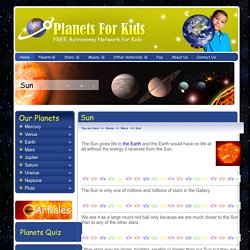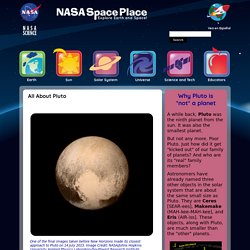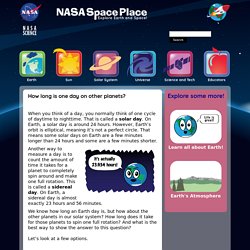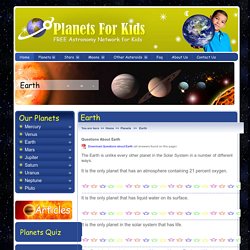

Digital Citizenship Reads. Unplugged by Steve Antony. Blackout. Spooky Stories Collection! The Sun Song/The Sun Song for Kids/Sun Song for Children. Our Sun - Sun For Kids - Facts About The Sun. The Sun gives life to the Earth and the Earth would have no life at all without the energy it receives from the Sun.

The Sun is only one of millions and millions of stars in the Galaxy. We see it as a large round red ball only because we are much closer to the Sun than to any of the other stars. Other stars may be larger, brighter, smaller or fainter than our Sun but they are so very far away that we only see them as points of light in the night sky. Orbit Facts for Kids. Rotation and Revolution of Earth. National Geographic Society. An axis is an invisible line around which an object rotates, or spins.

The object can be a tiny particle, smaller than a single atom. Or it could be a star with the mass of a thousand suns. In either case, an object's axis runs through its center of mass, or barycenter. An object's center of mass is a point where an outside force acting on the object acts as if the object were located at just that point—where the object appears "balanced. " Earth's center of mass actually varies. Each planet in our solar system rotates on its axis. The time it takes for a planet or other celestial object to complete one spin around its axis is called its rotation period.
Axial Tilt Some planets, such as Mercury, Venus, and Jupiter, have axes that are almost completely perpendicular, or straight up-and-down. NASA Space Place – NASA Science for Kids. One of the final images taken before New Horizons made its closest approach to Pluto on 14 July 2015.

Image Credit: NASA/Johns Hopkins University Applied Physics Laboratory/Southwest Research Institute Pluto is actually closer to the sun than Neptune for about 8% of its orbit.Pluto is just one of many icy objects in a distant area of our solar system.Pluto and its large, orbiting companion object Charon, are tipped on their sides. All of the above. Well, just pick the answer you like best, because they are all true! NASA Space Place – NASA Science for Kids. When you think of a day, you normally think of one cycle of daytime to nighttime.

That is called a solar day. On Earth, a solar day is around 24 hours. However, Earth’s orbit is elliptical, meaning it’s not a perfect circle. That means some solar days on Earth are a few minutes longer than 24 hours and some are a few minutes shorter. Another way to measure a day is to count the amount of time it takes for a planet to completely spin around and make one full rotation. We know how long an Earth day is, but how about the other planets in our solar system? Let’s look at a few options. Option 1: A Paragraph We can write a paragraph about how long days last on other planets. On Mercury a day lasts 1,408 hours, and on Venus it lasts 5,832 hours. Reading that paragraph took a while, and it’s hard to find all the numbers.
Option 2: A Table That’s a little bit better. Let’s make a graph with these numbers! Planets For Kids - Solar System Facts and Astronomy. What are the names of the nine planets? What are their characteristics? Earth Facts - Planet Earth - Earth For Kids. The Earth is unlike every other planet in the Solar System in a number of different ways.It is the only planet that has an atmosphere containing 21 percent oxygen.

It is the only planet that has liquid water on its surface. It is the only planet in the solar system that has life. The Earth is the only inner planet (Mercury, Venus, Earth and Mars) to have one large satellite, the Moon. Mars has two very tiny moons. Mercury and Venus have none. When viewed from outer space much of the Earth’s surface cannot be seen because of clouds of water vapour. 9 children's books about the planets and solar system. Sharing is caring - thank you for spreading the word!

I often joke to my husband that studying the universe hurts my brain because it is just so incredible to wrap my head around how utterly vast the universe is. It is slightly easier for me to contemplate our solar system. Although our solar system is still very big, it does seem a bit more knowable than our entire universe. In any case, our whole family had a great time to learning about the planets and solar system during our space unit. Solar System. Science Video for Kids: Earth's Revolution & Rotation. Astronomy 4 Kids: Rotation & revolution. Planets For Kids - Solar System Facts and Astronomy. What direction do planets rotate? (Beginner) - Curious About Astronomy? Ask an Astronomer. Rotation and Revolution of Earth. Exploring our solar system planets and space for kids. Planets of the solar system for kids - educational videos. Planets. There are more planets than stars in our galaxy. The current count orbiting our star: eight. The inner, rocky planets are Mercury, Venus, Earth and Mars.
The outer planets are gas giants Jupiter and Saturn and ice giants Uranus and Neptune. Beyond Neptune, a newer class of smaller worlds called dwarf planets reign, including longtime favorite Pluto. Planet Lineup. Britannica School.